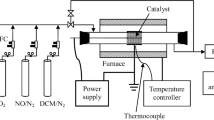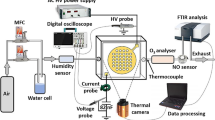Abstract
Controlled chemical transformation of water vapor in dielectric barrier discharge (DBD) of argon into hydrogen and hydrogen peroxide for its usability as in situ or ex situ H2 and H2O2 source are reported. Online analysis of the product gas mixture by conventional wet-chemical colorimetric method using buffered KI absorber solution revealed typical H2O2 G-value = 6.4 × 10−3 µmol J−1 (G-value defines as the number of molecules produced/consumed per 100 eV of energy; in SI unit G-value is expressed in µmol J−1) in the absence of ozone. On the other hand, H2 in product mixture analyzed in gas chromatograph-thermal conductivity detector (GC-TCD) with argon carrier revealed its G-value = 0.134 µmol J−1. Enhancements in products’ yields were explored by varying gas residence time inside the plasma zone, and applied voltage and frequency on the dielectric surfaces. Employing a double-DBD reactor, at applied high voltage ~2.5 kV mm−1 @50 Hz and gas residence time ~20 s resulted in the highest yields of H2O2. However, the H2 yield increased continuously with increase in gas residence time. On the other hand, the single-dielectric barrier surface reactors were more efficient for high and exclusive generation of ex situ H2 (e.g. maximum 1260 ppm; G-value typically 0.498 µmol J−1).







Similar content being viewed by others
References
Das TN, Dey GR (2013) J Hazard Mater 248–249:469–477
Dey GR, Sharma A, Pushpa KK, Das TN (2010) J Hazard Mater 178:693–698
Dey GR, Das TN (2013) IEEE Trans Plasma Sci 41:140–146
Guo Y, Liao X, Ye D (2008) J Environ Sci 20:1429–1432
Deynse V, De Geyter N, Leys C, Morent R (2014) Plasma Process Polym 11:117–125
Kawakami H, Zukeran A, Yasumoto K, Ehara Y, Yamamoto T (2013) IEEJ Trans Fund Mater 133:642–647
Lukes P, Locke BR (2005) J Phys D Appl Phys 38:4074–4081
Shih K-Y, Locke BR (2011) IEEE Trans Plasma Sci 39:883–892
Wang H, Li J, Quan X, Wu Y, Li G, Wang F (2007) J Hazard Mat 141:336–343
Lukes P, Appleton AT, Locke BR (2002) Published in industry applications conference, 37th IAS annual meeting, vol 3, pp 1816–1821
Ono R, Oda T (2003) J Appl Phys 93:5876–5882
Burlica R, Finney WC, Locke BR (2013) IEEE Trans Ind Appl 49:1098–1103
Anpilov AM, Barkhudrarov EM, Bark YB, Zadiraka YV, Christof M, Koztov YN, Kossyi IA, Kopev VA, Silakov VP, Taktakish MI, Temchin SM (2001) J Appl Phys 34:993–999
Dodet B, Odic E, Goldman A, Goldman M, Renard D (2005) J Adv Oxid Technol 8:91–97
Kirkpatrick MJ, Dodet B, Odic E (2007) Int J Plasma Environ Sci Technol 1:96–101
Velikonja J, Bergougnou MA, Peter Castle GS, Caims WL, Inculet I (2001) Ozone Sci Eng J Int Ozone Assoc 23:467–478
Falkenstein Z (1999) Ozone Sci Eng J Int Ozone Assoc 21:583–603
Kozlov KV, Odic E, Tatarenko PA, Dodet B, Fedoseev GS, Kirkpatrick MJ, Samoilovich VG, Ganciu M (2006) Published in “10th International Symposium on High Pres. Low Temp. Plasma, SAGA: Japan (2006)” hal-00221303, version 1–28 Jan 2008. http://citeseerx.ist.psu.edu/viewdoc/download?doi=10.1.1.372.1877&rep=rep1&type=pdf. Accessed 25 March 2015
Buckley PT, Birks JW (1995) Atmos Environ 29:2409–2415
Robert LH (1979) Toxicol Lett 4:449–453
Kogoma M, Miki Y, Tanaka K, Takahashi K (2006) Plasma Process Polym 3:727–733
Ghormley JA, Stewart AC (1956) J Am Chem Soc 78:2934–2939
Palmer DA, Ramette RW, Mesmer RE (1984) J Sol Chem 13:673–683
Awtrey AD, Connic RE (1951) J Am Chem Soc 73:1842–1843
Manley TC (1943) Trans Electrochem Soc 84:83–96
Flores-Fuentes A, Peña-Eguiluz R, López-Callejas R, Mercado-Cabrera A, Valencia-Alvarado R, Barocio-Delgado S, de la Piedad-Beneitez A (2009) IEEE Trans Plasma Sci 37:128–134
Kogelschatz U, Eliasson B, Egli W (1997) J de Phys IV 7:C4/47–C4/66
Dwivedi C, Toley MA, Dey GR, Das TN (2013) Ozone Sci Eng 35:134–145
Humidity calculator, http://www.humidity-calculator.com/index.php. Accessed 6 Jan 2015
H2O2 decomposition. http://en.wikipedia.org/wiki/Hydrogen_peroxide. Accessed 6 Jan 2015
Campos-Martin JM, Blanco-Brieva G, Fierro JLG (2006) Angew Chem Int Ed 45:6962–6984
Takechi K, Lieberman MA (2001) J Appl Phys 90:3205–3211
Kogelschatz U (2003) Plasma Chem Plasma Process 23:1–46
Eliasson B, Kogelschatz U (1988) Appl Phys B 46:299–303
Yoshinaga T, Akashi H (2013) J Phys: Conf Ser 441:012013
Ghassemi M, Mohseni H, Niayesh K, Shayegani AA (2012) IEEE Trans Dielect Elect Insul 19:865–876
Baricholo P, Hlatywayo DJ, von Bergmann HM, Stehmann T, Rohwer E, Collier M (2011) S Afr J Sci 107:Art. #581:1-7
Dielectric Barrier Discharge, Solved with COMSOL Multiphysics 4.4. https://www.comsol.co.in/model/download/186245/models.plasma.argon_dbd_1d.pdf. Accessed 25 March 2015
Acknowledgments
This research was carried out under the plan Project No: XII-N-R&D-02.1. Authors thank the Department of Atomic Energy, Government of India and Bhabha Atomic Research Centre for funds, and all members of Radiation & Photochemistry Division for their support.
Author information
Authors and Affiliations
Corresponding author
Electronic supplementary material
Below is the link to the electronic supplementary material.
Rights and permissions
About this article
Cite this article
Dey, G.R., Das, T.N. Yields of Hydrogen and Hydrogen Peroxide from Argon–Water Vapor in Dielectric Barrier Discharge. Plasma Chem Plasma Process 36, 523–534 (2016). https://doi.org/10.1007/s11090-015-9675-0
Received:
Accepted:
Published:
Issue Date:
DOI: https://doi.org/10.1007/s11090-015-9675-0




